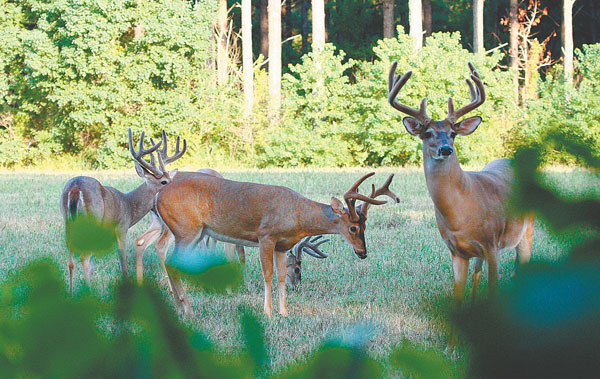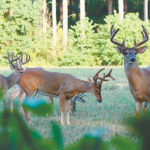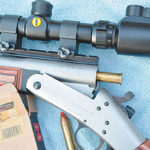
The Most Natural Calls on the Market
I was fighting the morning commute when my cell phone rang. I knew it had to be Carlos. It was deer season — and he calls me at the same time almost every morning to talk about deer, guns and hunting.
“How much?” were his first words.
“How much WHAT? Oh — that. Oh no buddy — it is NOT for sale.”
“C’mon. Everything’s got a price. How much?”
“You just want it because it’s sighted in already. What happened?”
“Man, my boy shot a buck with that thing, and it almost knocked the deer down. He staggered, then ran about 60 feet and dropped! C’mon. How much?”
“That thing” was my Confederate Valley Arms Optima Elite single-shot break-open rifle in .45-70 caliber — the old U.S. Army Trapdoor Springfield round from the late 1800s. It was also a popular buffalo hunting round in those years.
It stood to reason, if it would down a buffalo, it should make big medicine with something the size of a deer.
Our state the year before had followed Mississippi’s lead and approved some single-shot rifles for use during what used to be called “Blackpowder Season.”
That has evolved now to the more descriptive “Primitive Weapons Season.”
Basically, the rules have developed to a design of rifle and caliber that were in production and use before 1900. Our rules state that a muzzleloader or cap and ball rifle must have a caliber no less than .44.
A breech-loading single-shot cartridge rifle of a design manufactured before 1900 is also acceptable in calibers of .38 or larger. Some bills were introduced this year to allow some specific exceptions to the cartridge sizes in the breechloaders — check your hunting handbook for specific calibers allowed.
The second year, Carlos wanted to take advantage of the early season primitive weapons hunt for his kids. He called me to find out if I had anything they might use, and I told him of my CVA in .45-70. They scored the first morning — thus the plea for the sale of the gun.
When I wouldn’t sell, and he had more kids of age, Carlos went out and bought the most popular of these “primitive” rifles for the special season.
The Harrington & Richardson (or “H&R” as it is universally known) “Handi-Rifle” has become the go-to weapon for some states with primitive rifle seasons.
Relatively inexpensive, these range in price from just under $300 in the plain-Jane package of blued steel and injection-molded stock to laminated, thumb-hole stocks with stainless breeches and barrels.
Their barrels are interchangeable with a plethora of calibers and even shotgun barrels. They are single-shot — but they are versatile.
As it turns out, they shoot really, really well, too.
Carlos — ever outfitting a growing brood — had bought two Handi-Rifles, both in .45-70.
If you are not familiar with this caliber, the designation relates to .45-caliber bullets being pushed by 70 grains of black powder — a stout load in anyone’s rifle book. Modern manufacture has made this a much more powerful round than those blackpowder rounds from yesteryear — under NO circumstances should you attempt to fire a modern .45-70 cartridge in one of the old rifles designed for the blackpowder round.
Just as the Handi-Rifle has become the “go-to” in the primitive designs, so everyone is going to the Hornady LeveRevolution for their cartridges.
This pushes a 325-grain bullet downrange at 2,050 feet per second. The ballistic table shows the cartridge now is reasonable for use at up to 200-yard ranges.
Unfortunately, when 325 grains is being pushed down a barrel, something pushes back on the other end. I discovered this when Carlos asked me to come to their deer club and sight in the two Handi-Rifles for him.
He bought what was available at the gun store — one blued-steel barrel with an injection-molded stock, and a high-end model with a stainless barrel and breech, and a blonde laminated stock with a thumbhole. The blued gun was outfitted with a low-end Simmons 3-9×40, and the stainless version with a BSA Catseye in 3-10×44.
I did not expect these two rifles to match accuracy with my CVA Optima Elite with its custom Spanish Bergara barrel — it makes three-shot ragged holes at 100 yards.
I also did not expect the kick.
Taking the boresighted rifles down to 25 yards, I flopped my Shooters Edge shooting bag on the back of my ATV and laid the plane-Jane version over the bag. I wanted to be sure the rifle was on the paper, then move back to 100 yards and sight it in.
Wearing earplugs, I sighted through the scope, and pulled the trigger on the little rifle. These are smaller rifles, suitable for kids — in size, at least.
I’m not recoil-sensitive. But at the report, something like the Hammer of Thor slammed into my shoulder, rocking me backwards, my head swimming.
“Dammit, Carlos” I said, wiping my eyes behind my shooting glasses.
I tried the old trick of doubling a towel on my shoulder, but the recoil was just too brutal. I sent Carlos back to the camp to get their Caldwell Lead Sled.
This is a rifle-sighting system that supports the rifle and allows you to move the stock rest into your shoulder — a pan under the rest allows you to set bags of lead shot, or any heavy material, to reduce the felt recoil. Interestingly, these handy tools also improve your ability to sight in your rifle by giving you a solid rest front and rear — removing the hassle of scope “wobble” even on two sandbags.
After using the sled to get on the paper, I moved both rifles back to the 100-yard bench and proceeded to easily walk both of them into sighting about 2 inches high at 100 yards, which gave them margin of error to simply aim at the deer all the way out to 150 yards — a really long shot at this club.
The combination of Hornady ammo and the little Handi-Rifles was impressive.
Both rifles printed exceptional groups of three shots under 1 inch at 100 yards, rivaling the accuracy of my CVA. I was astonished at the accuracy from both of these rifles. No slouches in the accuracy department, you get a rifle that carries well, shoots a cartridge that absolutely stomps a deer, and is amazingly accurate at a fair price.
I’d be cautious letting a kid shoot these without some sort of recoil reducer on the range. Another excellent idea would be to buy a spare barrel or two — one in shotgun, and another in a lighter, less-recoiling round for plinking, or hunting during regular deer season. Nobody, kids included, pays any attention to recoil when shooting at a deer. Let them sight them in with the lesser recoiling round, and switch over to the heavier round for the primitive season.
I wish I had known just how accurate and dependable these Handi-Rifles were when I was starting out my boys. All the scrabbling around to find them suitable shotguns and rifles for the various seasons could easily (and inexpensively) have been solved with the purchase of one basic gun, and several interchangeable barrels.




